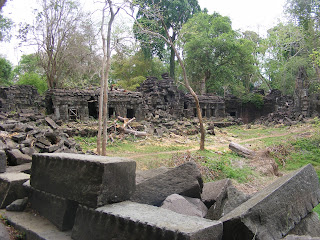I visited Cambodia with an old university friend, Christopher, who has travelled extensively in the region. A 24-hour flight took me to Singapore where I spent a night with cousins Harry and Claire Taylor. Chris and I met the next day at the classic Raffles Hotel, and flew on to Siem Reap in north-western Cambodia. We stayed in a delightful hotel which was almost empty, it now being low season - hot and steamy and threatening the start of the rains.
Temples 1
Angkor Wat lies 20 minutes north of Siem Reap by tuktuk (motorcycle taxi.)
It was the centre of the Angkorean Empire which flourished more or less from 802 to 1431 AD, extending at its zenith to much of Indo-China and parts of Thailand. Angkor Wat (temple) itself, dating basically from the C12th, is the largest religious complex in the world and a UNESCO world heritage site.

It is mainly the work of two kings, Suryavarman II and Jayavarman VII, but the earliest surviving temples in the area date back several centuries further. Just north of the temple is the old walled city of Angkor Thom, approx 3 km square! This still contains a few temples and the ruins of the royal palace complex, but most of the city would have been constructed of wood so nothing remains and the forest has flowed back in. No doubt much more can be learnt from archaeological digs across the city but as a tourist one is directed to the enormous sandstone ruins which do remain. We spent over a week here in total, visiting the ruins in the immediate vicinity and going further afield on day excursions.
The earliest temple which we saw – Baksei Chamkrong – dates from the C9th.

It is Hindu, as were all the dedications up to (effectively) the reign of Jayavarman VII, who followed his short-lived father in being a Bhuddist. After his death there was a Hindu reaction and a lot of Bhuddist iconry was destroyed or defaced.
The temples have also, of course, suffered extensive looting over the years, or simply collapsed. Angkor Wat is in extraordinarily good repair, although some restoration has been necessary. Within Angkor Thom is a temple called the Bayon, constructed by Jayavarman VII and containing numerous towers with multiple faces on them, possibly dedicated to Bhudda but apparently portraits of the king himself.

 We stopped for lunch in the hamlet of San Felix - comida típica (chicken and peas!), followed by a sietsta outside in the square.
Then down the valley again to the coast. A few miles short of Huasco is Freirina, famous for a C19th church and a slightly earlier classical style wooden house named for Diego Portales. Both were undergoing major restoration.
We stopped for lunch in the hamlet of San Felix - comida típica (chicken and peas!), followed by a sietsta outside in the square.
Then down the valley again to the coast. A few miles short of Huasco is Freirina, famous for a C19th church and a slightly earlier classical style wooden house named for Diego Portales. Both were undergoing major restoration. We diverted south on 40 km of dirt road (seeing a burrowing owl on the way)
We diverted south on 40 km of dirt road (seeing a burrowing owl on the way) to see some industrial archaeology - one of the earliest copper foundries in Chile (1846), with two elegant, slender chimneys built of bricks imported from England.
to see some industrial archaeology - one of the earliest copper foundries in Chile (1846), with two elegant, slender chimneys built of bricks imported from England.
 On the road there were a couple of abandoned villages and a cemetery.
On the road there were a couple of abandoned villages and a cemetery. Also several little farms with herds of goats.
Supper in a fish restaurant in Huasco.
The next day we went to Llanos de Challe national park some 40 km north where we walked on the trails. We saw some ancient corrals, a lot of dried up vegetation but no flowering desert which was our aim. However we saw two guanacos,
Also several little farms with herds of goats.
Supper in a fish restaurant in Huasco.
The next day we went to Llanos de Challe national park some 40 km north where we walked on the trails. We saw some ancient corrals, a lot of dried up vegetation but no flowering desert which was our aim. However we saw two guanacos,  which was quite special, and ate our picnic lunch beside a wetland at Carrizal Bajo where we saw coscoroba swans.
which was quite special, and ate our picnic lunch beside a wetland at Carrizal Bajo where we saw coscoroba swans.  There was a charming church with the town library beside it.
There was a charming church with the town library beside it.
 On the way back we stopped at an olive farm where they have 400-year-old olive trees, brought in by the Spanish in the 16th century to compensate the natives for having virtually enslaved them under the encomienda system...
On the way back we stopped at an olive farm where they have 400-year-old olive trees, brought in by the Spanish in the 16th century to compensate the natives for having virtually enslaved them under the encomienda system...






























